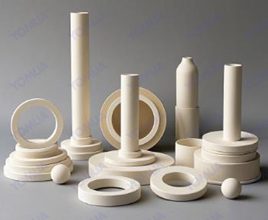The price of advanced ceramics remains high due to a combination of factors, including complex manufacturing processes, high raw material costs, significant technical barriers, and relatively limited market demand. Below is a detailed analysis of the reasons behind the high costs, along with potential strategies to reduce them.

1. High Raw Material Costs
- High-Purity Materials: Advanced ceramics (e.g., silicon nitride, silicon carbide, zirconia) require high-purity raw materials, which are expensive to extract and refine.
- Rare Elements: Some advanced ceramics need rare elements (e.g., yttrium, lanthanum) to enhance their properties. These elements are costly and often subject to supply chain instability.
2. Complex Manufacturing Processes
- Precision Processing: The production of advanced ceramics involves multiple steps, including powder synthesis, shaping, sintering, and precision machining, each requiring advanced equipment and expertise.
- Demanding Sintering Conditions: Many advanced ceramics require sintering at high temperatures and pressures, which involves significant energy consumption and expensive equipment.
- Low Yield Rates: Ceramics are inherently brittle, making them prone to defects such as cracks and pores during processing. This results in lower yield rates and higher costs.
3. High Technical Barriers
- Substantial R&D Investment: Developing advanced ceramics requires significant investment in research and development, spanning materials science, process engineering, and equipment manufacturing.
- Patent Barriers: Core technologies for many advanced ceramics are monopolized by a few companies, leading to high costs for technology transfer and licensing.
4. High Equipment and Process Costs
- Specialized Equipment: Producing advanced ceramics requires specialized equipment, such as high-temperature sintering furnaces and precision machining tools, which are expensive to purchase and maintain.
- Process Optimization Challenges: Different applications require tailored ceramic properties, necessitating continuous optimization of process parameters, which increases R&D and production costs.
5. Limited Market Demand
- Niche Market: Advanced ceramics are primarily used in high-end industries (e.g., aerospace, semiconductors, medical devices), where demand is relatively small, making it difficult to achieve economies of scale.
- Customization Needs: Many applications require customized ceramic components, which cannot be mass-produced, further limiting cost reduction opportunities.
6. Environmental and Energy Costs
- High Energy Consumption: The manufacturing processes for advanced ceramics, such as high-temperature sintering, are energy-intensive, driving up production costs.
- Environmental Regulations: Ceramic production can generate pollutants (e.g., exhaust gases, wastewater), necessitating costly environmental protection measures.
7. Supply Chain and Logistics Costs
- Complex Supply Chains: The raw material supply chain for advanced ceramics is lengthy, involving mining, purification, and transportation, each adding to the cost.
- High Logistics Costs: Ceramics are fragile and require special handling during transportation and storage, increasing logistics expenses.
8. Rapid Technological Updates
- Frequent Iterations: The rapid pace of technological advancements in advanced ceramics requires continuous R&D investment to remain competitive.
- Equipment Upgrades: Adopting new technologies often necessitates upgrading production equipment, further increasing capital expenditure.
Summary Table:
Reasons for High Costs and Potential Solutions
| Factor | Description | Potential Solutions |
|---|---|---|
| High Raw Material Costs | High-purity materials and rare elements are expensive. | Develop low-cost alternatives; reduce rare element usage. |
| Complex Manufacturing | Multi-step processes with high precision and energy demands. | Optimize processes; invest in energy-efficient technologies. |
| High Technical Barriers | Significant R&D investment and patent monopolies. | Foster collaborative R&D; promote open innovation. |
| High Equipment Costs | Specialized equipment is expensive to purchase and maintain. | Localize equipment production; adopt automation and AI. |
| Limited Market Demand | Niche applications and customization limit economies of scale. | Expand into emerging markets (e.g., renewable energy, electric vehicles). |
| Environmental Costs | High energy consumption and pollution control increase costs. | Implement green manufacturing practices; recycle materials. |
| Supply Chain Costs | Long and complex supply chains with high logistics expenses. | Streamline supply chains; use local sourcing where possible. |
| Rapid Technological Updates | Frequent iterations and equipment upgrades drive up costs. | Focus on modular and upgradable equipment; invest in scalable technologies. |
Conclusion
The high price of advanced ceramics is driven by factors such as high-purity raw material costs, complex manufacturing processes, significant technical barriers, high equipment investments, niche market demand, environmental and supply chain costs, and rapid technological updates. While these challenges make it difficult to reduce prices in the short term, strategies such as process optimization, scaling up production, raw material substitution, equipment localization, and recycling could help lower costs in the future, enabling broader adoption of advanced ceramics.
Additional Insights
- Emerging Markets: Expanding into new markets, such as renewable energy (e.g., fuel cells, solar panels) and electric vehicles (e.g., battery components), could increase demand and drive economies of scale.
- Collaborative R&D: Partnerships between academia, industry, and government could accelerate innovation and reduce R&D costs.
- Automation and AI: Implementing automation and artificial intelligence in manufacturing processes could improve efficiency and reduce labor costs.
By addressing these challenges and leveraging new opportunities, the advanced ceramics industry can work toward making these materials more accessible and affordable for a wider range of applications.